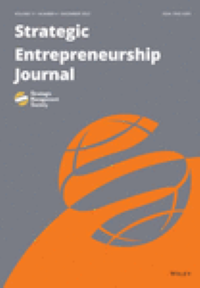向何处投资?技术能力对企业风险投资的影响
IF 6.3
2区 管理学
Q1 BUSINESS
引用次数: 0
摘要
研究摘要我们研究了为什么企业投资者在某些领域的企业风险资本(CVC)投资多于其他领域。我们以企业在不同技术领域的不同技术能力为重点,认为企业投资者在某一领域的技术能力会影响其投资于(1)该领域内风险企业的可能性,呈倒 U 型;(2)在其他技术互补领域运营的风险企业的可能性,呈正向。我们还认为,技术能力与风险投资可能性之间的这两种关系受重点领域技术增长率的影响。我们在美国医疗行业检验了这些论点,该行业中的在位企业积极进行 CVC 投资,以此获取外部知识。我们在美国医疗行业的研究结果表明,企业最有可能投资于其技术能力适中的风险投资领域--既不会太弱,也不会太强。这表明,风险投资公司的投资起到了填补技术中间产品空白的作用。此外,企业投资者倾向于投资与其优势领域在技术上互补的领域内的风险企业。然而,当某一领域出现快速增长时,该领域的技术领先者会将其 CVC 投资重点从互补领域转向该领域,以保持其领先地位。本文章由计算机程序翻译,如有差异,请以英文原文为准。
Where to invest? Effects of technological capabilities on corporate venture capital investments
Research SummaryWe investigate why a corporate investor makes more corporate venture capital (CVC) investments in certain areas than in others. Focusing on firms' different technological capabilities across distinct technology domains, we argue that a corporate investor's technological capabilities in a given domain affect its likelihood of investing in (1) ventures within the domain in an inverted U‐shaped manner and (2) ventures operating in other technologically complementary domains in a positive manner. We further claim that these two suggested relationships between technological capabilities and the likelihood of CVC investments are shaped by the technology growth rate of the focal domain. We test these arguments in the US medical sector, where incumbent firms are active in CVC investments as a means to acquire external knowledge.Managerial SummaryWe argue that firms exhibit different patterns in their choice of CVC investment areas based on their technological capabilities within a given technology domain. Our findings in the US medical sector indicate that firms are most likely to invest in ventures within domains where their technological capabilities are moderate—neither too weak nor too strong. This suggests that CVC investments serve gap‐filling purposes for technology intermediates. Moreover, corporate investors tend to invest in ventures within domains that are technologically complementary to their areas of strength. However, when a given domain experiences rapid growth, technology leaders in that domain shift their CVC investment focus from complementary areas to that domain to maintain their leading position.
求助全文
通过发布文献求助,成功后即可免费获取论文全文。
去求助
来源期刊

Strategic Entrepreneurship Journal
Multiple-
CiteScore
11.10
自引率
1.60%
发文量
31
期刊介绍:
The Strategic Entrepreneurship Journal is a research journal that publishes original work recommended by a developmental, double-blind review process conducted by peer scholars. Strategic entrepreneurship involves innovation and subsequent changes which add value to society and which change societal life in ways which have significant, sustainable, and durable consequences. The SEJ is international in scope and acknowledges theory- and evidence-based research conducted and/or applied in all regions of the world. It is devoted to content and quality standards based on scientific method, relevant theory, tested or testable propositions, and appropriate data and evidence, all replicable by others, and all representing original contributions. The SEJ values contributions which lead to improved practice of managing organizations as they deal with the entrepreneurial process involving imagination, insight, invention, and innovation and the inevitable changes and transformations that result and benefit society.
 求助内容:
求助内容: 应助结果提醒方式:
应助结果提醒方式:


